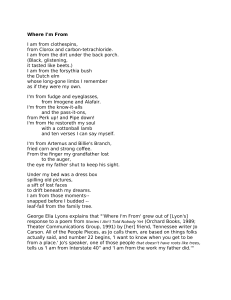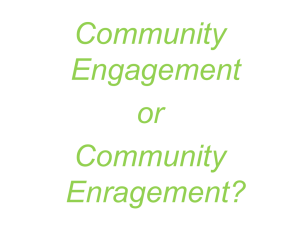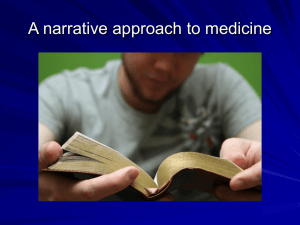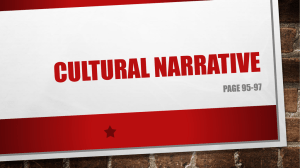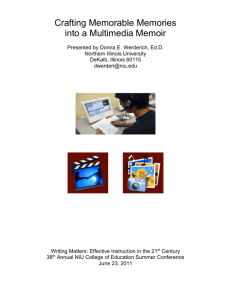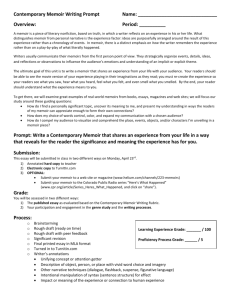Student Autobiography * Livebinder
advertisement
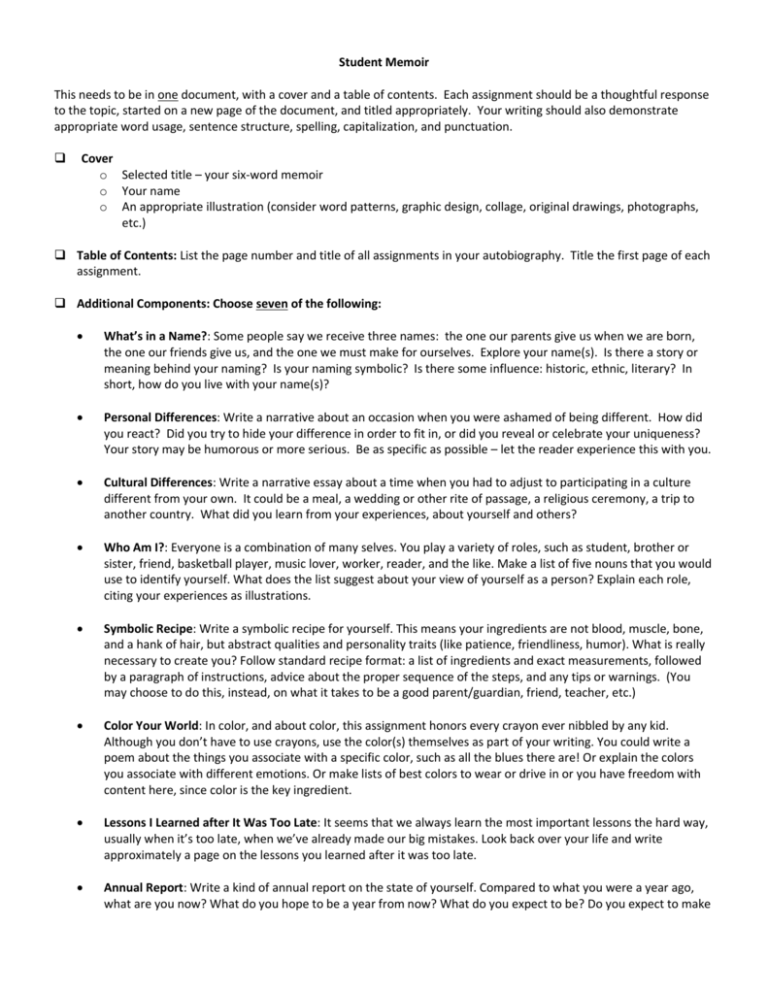
Student Memoir This needs to be in one document, with a cover and a table of contents. Each assignment should be a thoughtful response to the topic, started on a new page of the document, and titled appropriately. Your writing should also demonstrate appropriate word usage, sentence structure, spelling, capitalization, and punctuation. Cover o Selected title – your six-word memoir o Your name o An appropriate illustration (consider word patterns, graphic design, collage, original drawings, photographs, etc.) Table of Contents: List the page number and title of all assignments in your autobiography. Title the first page of each assignment. Additional Components: Choose seven of the following: What’s in a Name?: Some people say we receive three names: the one our parents give us when we are born, the one our friends give us, and the one we must make for ourselves. Explore your name(s). Is there a story or meaning behind your naming? Is your naming symbolic? Is there some influence: historic, ethnic, literary? In short, how do you live with your name(s)? Personal Differences: Write a narrative about an occasion when you were ashamed of being different. How did you react? Did you try to hide your difference in order to fit in, or did you reveal or celebrate your uniqueness? Your story may be humorous or more serious. Be as specific as possible – let the reader experience this with you. Cultural Differences: Write a narrative essay about a time when you had to adjust to participating in a culture different from your own. It could be a meal, a wedding or other rite of passage, a religious ceremony, a trip to another country. What did you learn from your experiences, about yourself and others? Who Am I?: Everyone is a combination of many selves. You play a variety of roles, such as student, brother or sister, friend, basketball player, music lover, worker, reader, and the like. Make a list of five nouns that you would use to identify yourself. What does the list suggest about your view of yourself as a person? Explain each role, citing your experiences as illustrations. Symbolic Recipe: Write a symbolic recipe for yourself. This means your ingredients are not blood, muscle, bone, and a hank of hair, but abstract qualities and personality traits (like patience, friendliness, humor). What is really necessary to create you? Follow standard recipe format: a list of ingredients and exact measurements, followed by a paragraph of instructions, advice about the proper sequence of the steps, and any tips or warnings. (You may choose to do this, instead, on what it takes to be a good parent/guardian, friend, teacher, etc.) Color Your World: In color, and about color, this assignment honors every crayon ever nibbled by any kid. Although you don’t have to use crayons, use the color(s) themselves as part of your writing. You could write a poem about the things you associate with a specific color, such as all the blues there are! Or explain the colors you associate with different emotions. Or make lists of best colors to wear or drive in or you have freedom with content here, since color is the key ingredient. Lessons I Learned after It Was Too Late: It seems that we always learn the most important lessons the hard way, usually when it’s too late, when we’ve already made our big mistakes. Look back over your life and write approximately a page on the lessons you learned after it was too late. Annual Report: Write a kind of annual report on the state of yourself. Compared to what you were a year ago, what are you now? What do you hope to be a year from now? What do you expect to be? Do you expect to make “progress”? If so, how has your last year proven your ability to progress? Are you better off than you were a year ago? Or worse off? Biographical Narrative: What makes a person stand out over another in our memory? We might have 27 aunts and uncles, but there’s one who somehow remains in our mind long after the others go to bed. We sit in the classrooms of dozens of teachers in a lifetime, but one or two we never forget. Think and write about a person (alive or not) who remains very memorable to you. Describe this person so we can see his or her; show him/her doing something memorable; explain what makes him/her memorable; discuss the influences this person has had on you and/or others. Futures – Fantasy and Fact:(1) Pretend that you can see yourself ten years from now. Describe your future as it could be if all your wishes came true. This description is “romantic.” (2) Describe what your life will be like ten years from now if you continue just as you are now. No miracles or magic allowed. This view is “realistic.” For most people, the “romantic” and “realistic” descriptions are very different. (3) Analyze the discrepancy. Discuss the specific differences between your two descriptions and how you feel about these differences. Finally, explain the steps you can take to find a sensible compromise between the romantic and the realistic. Where I’m From: Using George Ella Lyon’s poem as your inspiration, compile a list of specifics that reveal your roots. Specificity is the key – exact things, places, traditions, sayings. Let where, what and who you are from reveal how you have become who you are now. Where I’m From 5 10 15 20 I am from clothespins, from Clorox and carbon-tetrachloride. I am from the dirt under the back porch. (Black, glistening, it tasted like beets.) I am from the forsythia bush the Dutch elm whose long-gone limbs I remember as if they were my own. I'm from fudge and eyeglasses, from Imogene and Alafair. I'm from the know-it-alls and the pass-it-ons, from Perk up! and Pipe down! I'm from Herestoreth my soul with a cottonball lamb and ten verses I can say myself. I'm from Artemus and Billie's Branch, fried corn and strong coffee. From the finger my grandfather lost to the auger, the eye my father shut to keep his sight. Under my bed was a dress box spilling old pictures, a sift of lost faces to drift beneath my dreams. 25 I am from those moments – snapped before I budded – leaf-fall from the family tree.
